African Grey parrots are widely considered the smartest and most intelligent talking birds in the world, capable of growing a vocabulary of hundreds of words. This remarkable ability has captivated bird enthusiasts for generations, making them one of the most popular avian companions. But African Greys are just the tip of the iceberg when it comes to talkative pet birds.
Budgerigars, also known as budgies or parakeets, have broken world records for the largest bird vocabulary, showcasing their potential to learn a variety of songs and phrases. These tiny feathered friends can develop vocabularies of hundreds of words, making them true linguistic virtuosos. From parrots to parakeets, the world of talking pet birds is truly astounding.
Key Takeaways
- Talking pet birds can learn hundreds to thousands of words and phrases, showcasing remarkable vocal mimicry abilities.
- Popular talking bird species include African Grey parrots, budgies, Amazon parrots, and more, each with unique personalities and care requirements.
- Caring for a talking bird requires patience, dedication, and a stimulating environment to support their cognitive and social needs.
- The cost of acquiring a talking parrot can range from $20 to $5000, depending on the species and individual bird characteristics.
- Talking birds make engaging, intelligent companions for experienced bird owners, but their care needs should be carefully considered.
Introduction to Talking Pet Birds
The ability of certain bird species to mimic human speech and other sounds is a truly remarkable phenomenon. Known as avian vocal mimicry, this talent allows birds to repeat words, phrases, and even songs with impressive clarity and accuracy. As you’ll discover, some of the most popular talking bird breeds include African grey parrots, budgies, Amazon parrots, and more. Each species has its own unique strengths and personalities, making them engaging and entertaining talkative pet bird companions for the right owners. However, caring for a verbal parrot requires a significant time commitment and specialized knowledge to ensure their needs are fully met.
The Fascinating Ability of Vocal Mimicry
Birds possess a unique anatomical structure called a syrinx, located in the lower portion of their trachea, which enables them to produce a wide range of sounds, including conversational bird training. This distinct mechanism differs from the way mammals use their larynx, tongue, and mouth/lips for sound production. Certain bird species, such as parrots, corvids, and mynas, have developed the remarkable ability to mimic human speech and other complex sounds with incredible accuracy.
Exploring the World of Talkative Avian Companions
From the bird speech development of small budgies to the impressive vocabularies of Amazon parrots, the world of talking pet birds is truly captivating. These feathered friends not only delight their owners with their vocal abilities but also require dedicated care and attention to thrive. Teaching birds to talk effectively can be a rewarding experience, but it demands patience, consistency, and a deep understanding of each species’ unique needs and behaviors.
“Budgies, also known as parakeets, like Disco the talking budgie featured in the video, can produce more than one hundred phrases, showcasing their potential for talking abilities.”
As you embark on your journey with talkative avian companions, it’s important to remember that the time and effort invested in conversational bird training can yield incredible rewards. With the right approach and dedication, you may be amazed by the bird speech development and avian vocal mimicry displayed by your feathered friend.
African Grey Parrots: The Einsteins of the Avian World
Among the talking parrot species, the African grey parrot stands out as a true marvel. These remarkable avians are widely considered the most intelligent and talented talkers in the avian world. With the ability to develop vocabularies of up to 1,000 words, African grey parrots can speak with exceptional clarity, often fooling listeners into thinking a human is the one speaking.
Remarkable Vocabulary and Speech Clarity
The African grey parrot’s ability to mimic sounds, including human voices, is truly astounding. These birds possess an incredible capacity for vocal mimicry, which they begin developing around the age of one. By the time they reach adulthood, most African greys have become masters of imitation, able to reproduce a wide range of sounds with remarkable accuracy.
Intelligent and Engaging Personalities
Beyond their exceptional vocal prowess, African grey parrots are also highly intelligent and engaging companions. Forming strong bonds with their owners, these birds are known for their problem-solving skills, curiosity, and ability to understand and respond to human emotions. However, their advanced care requirements and potential for behavioral issues mean they are best suited for experienced bird owners with the time and patience to provide the specialized attention these birds need.
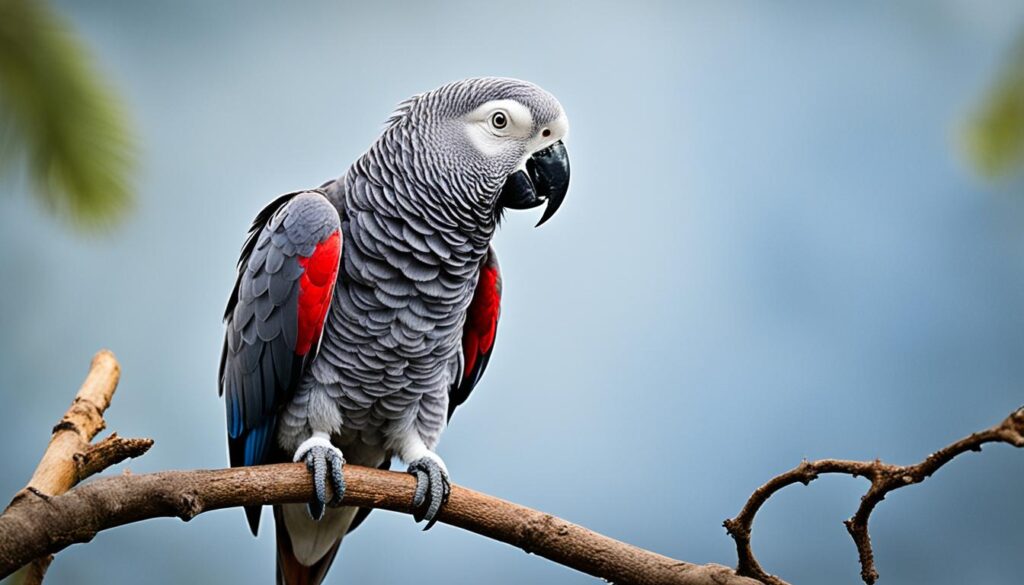
“African grey parrots are often referred to as ‘The Einsteins of the Bird World’ due to their extreme intelligence.”
African grey parrots have been the subject of extensive research, with studies showcasing their remarkable cognitive abilities. For example, the famous African grey parrot named Alex, who lived at the Brandeis University and MIT, could recognize and identify objects, colors, shapes, understand the concepts of same and different, category, and even count objects. This level of intelligence is truly astounding, earning African greys their reputation as the “Einsteins of the Avian World.”
While these birds make captivating companions, their advanced care requirements and potential for behavioral issues mean they are best suited for experienced bird owners who can provide the specialized attention and enrichment these intelligent birds require. With the right care and dedication, however, African grey parrots can be truly remarkable and engaging feathered friends.
Budgerigars: Tiny but Mighty Talkers
It may come as a surprise to learn that the small, unassuming budgie, or parakeet, is actually one of the most talented talking birds. These diminutive avians have been known to develop vocabularies of hundreds of words, despite their gruff, slightly garbled voices. Budgies are affordable, social, and often content to spend time in a large cage while their owners are at work, making them a more manageable option for those interested in a talking pet bird.
With proper socialization and training from a young age, budgies can become delightful chatterboxes. Their average lifespan of 15 years in captivity means that budgie owners can enjoy their vocal abilities for many years. However, these tiny birds require attentive care, as they can be susceptible to health issues like vitamin deficiencies and throat damage if not provided with a balanced diet and proper veterinary attention.
Budgies are known to exhibit some interesting behaviors, such as their ability to interact with voice recognition software or even chase after other bird species. Their active and nimble nature can also lead to them becoming skilled escape artists, making it crucial for owners to ensure their enclosures are secure. Despite their small size, budgies can be expensive to care for, often requiring specialized attention from avian veterinarians.
“Budgerigars can develop vocabularies of hundreds of words, despite their gruff, slightly garbled voices.”
It’s important for budgie owners to be mindful of their pet’s environment, as these birds may inadvertently injure themselves by flying into closed doors or other obstacles. Additionally, some budgies may be undervalued or neglected by owners due to their relatively low cost and perceived disposability, leading to concerns about their overall welfare.
Whether you’re interested in a talking parakeet or a verbal parrot, budgies can make engaging and rewarding companions with the right care and attention. With their impressive bird speech development capabilities and charming personalities, these tiny talkers are sure to delight bird enthusiasts of all ages.
Amazon Parrots: Clear Voices and Large Vocabularies
Among the talking parrot species, the Amazon parrots stand out for their exceptional verbal abilities. These beautiful, green-feathered birds are renowned for not only building impressive vocabularies, but also for their remarkably clear and pleasant-sounding voices. The yellow-naped Amazon, in particular, is considered the best talker within the Amazon parrot group, capable of stringing together coherent sentences and understanding the context and tempo of conversations.
The Exceptional Yellow-Naped Amazon
While Amazon parrots require a significant time commitment and may develop moody or aggressive tendencies, their advanced vocal skills make them a rewarding choice for experienced bird owners. The yellow-naped Amazon, in particular, is widely regarded as the most exceptional talking Amazon parrot species. These parrots have the ability to mimic human speech with impressive clarity, often speaking in full sentences and demonstrating a keen understanding of the appropriate tone and inflection.
In addition to their verbal prowess, yellow-naped Amazons are known for their calm demeanor and gentle personalities, making them engaging companions for those willing to invest the time and effort required to care for these intelligent and talkative birds.
“Amazon parrots are among the best talking parrots, with the yellow-naped variety considered the most exceptional in terms of speech development and clarity.”
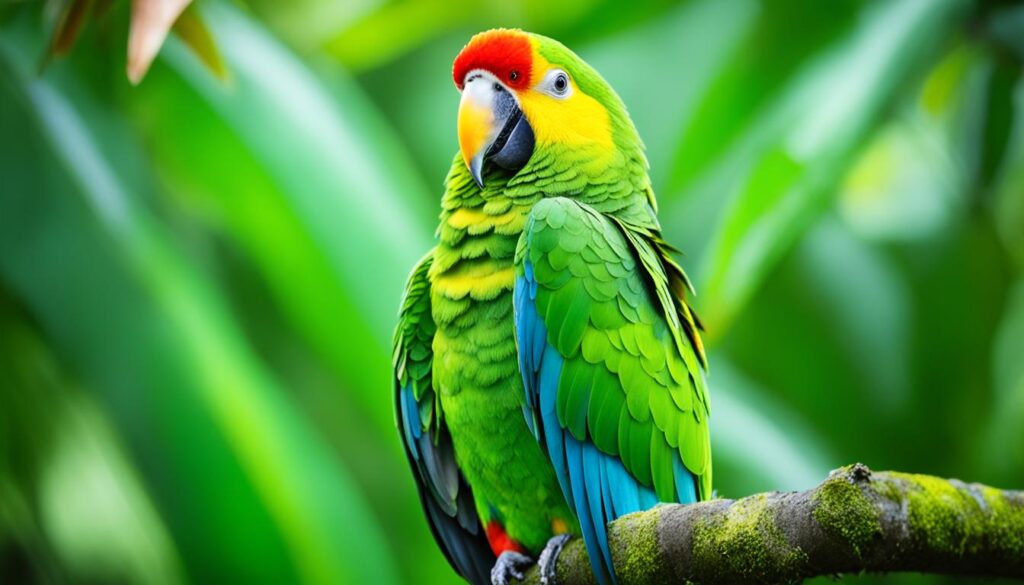
While not all Amazon parrots may exhibit the same level of talking ability as the yellow-naped variety, these birds as a whole are renowned for their large vocabularies and the clarity of their speech. With proper training and a nurturing environment, Amazon parrots can become delightful and engaging verbal companions, making them a popular choice among experienced bird owners.
Quaker Parrots: Charming and Quick Learners
The adorable Quaker parrots, also known as monk parakeets, have long been prized for their talking talents and charming personalities. Quakers are able to build quite large vocabularies, and some Quaker owners swear that their birds are even able to use their words in context. In addition to mimicking human speech, Quakers can also easily pick up on and repeat a variety of household sounds, from barking dogs to ringing phones.
Mimic Household Sounds with Ease
While their voices may not be as clear as some other talking birds, Quakers’ quick learning abilities and gentle demeanors make them an excellent choice for beginner bird owners. The lifespan of a Quaker parakeet can reach up to 30 years with proper care, and they are known to start talking at a relatively young age, showcasing their impressive speech development.
Quaker parrots are social animals and can become depressed if left alone for extended periods. They are excellent talkers, able to learn a variety of words and phrases, making them engaging companions. However, health-wise, common issues with Quaker parrots include feather destructive behaviors and fatty liver disease, which is linked to a high-fat diet.
“Quaker parrots are charming and quick learners, able to mimic a wide range of household sounds with ease.”
Due to their destructive tendencies in the wild, Quaker parakeets are illegal in some states, prompting the need to check local laws before owning one. With their endearing personalities and impressive vocal abilities, Quaker parrots make wonderful pets for those willing to provide the necessary care and attention.
what pet birds talk
While not all pet birds have the natural inclination or ability to talk, there are several species that are renowned for their impressive vocal talents. From the highly intelligent African grey parrots to the cheerful and charming Indian Ringneck parakeets, the world of talking pet birds is truly fascinating.
Some of the most well-known talking bird species include:
- African Grey Parrots – Known as the “Einsteins of the Avian World”, these birds are renowned for their remarkable vocabulary and speech clarity.
- Budgies – Also known as parakeets, these tiny birds have the ability to mimic speech, although not all budgies will talk despite having this talent.
- Amazon Parrots – These birds, particularly the Yellow-Naped Amazon, are praised for the clarity of their voices, often compared to human speech, and their ability to sing songs.
- Quaker Parrots – Considered natural talkers, these charming birds can even start talking before being weaned.
- Indian Ringneck Parakeets – Capable of mastering longer phrases and sentences, these birds have a cheerful and cartoonish-sounding voice.
Other notable talking bird species include cockatoos, eclectus parrots, severe macaws, and mynah birds, each with their own unique strengths and characteristics when it comes to mimicry, vocabulary size, and speech clarity.
Factors like genetics, early socialization, and the owner’s dedication to training all play a crucial role in determining how well a bird will develop its talking abilities. With the right care and attention, many pet birds can become delightful and engaging conversational companions.
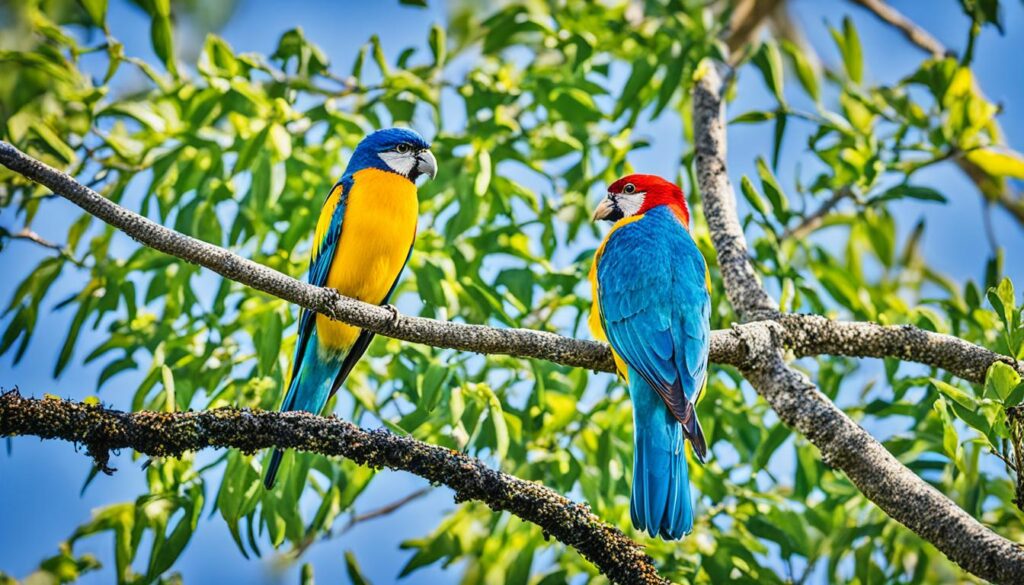
“An African Grey parrot named Alex had the remarkable ability to solve complex problems.”
Indian Ringneck Parakeets: Revered for Their Speaking Talents
Hailing from the lush landscapes of India and Asia, the captivating Indian Ringneck parakeet, also known as the rose-ringed parakeet, has been cherished as a beloved pet for centuries. These charming feathered companions are renowned for their exceptional ability to mimic human speech, making them a popular choice among avian enthusiasts.
Mastering Longer Phrases and Sentences
Unlike many other parrot species that are limited to single-word imitation, Indian Ringneck parakeets have the remarkable capacity to learn and recite longer phrases and even complete sentences. Their clear, distinct voices and natural talent for verbal mimicry make them engaging and entertaining companions for owners willing to invest the time and patience required to train them.
In fact, these birds were once reserved exclusively for royalty, as monks in temple gardens observed them reciting daily prayers in a mesmerizing display of their linguistic prowess. Today, Indian Ringnecks continue to captivate bird lovers with their ability to master a wide range of vocalizations, from simple greetings to complex conversations.
Whether it’s mimicking household sounds, imitating their owners’ voices, or engaging in interactive “dialogues,” these talking parrots have earned a reputation as some of the most verbally talented avian companions. Their impressive speech development is a testament to their intelligence and adaptability, making them a prime choice for those seeking a pet that can engage in entertaining exchanges.
“Indian Ringneck parakeets are truly remarkable birds, capable of learning and repeating longer phrases and even complete sentences with remarkable clarity. Their ability to vocalize is a testament to their intelligence and trainability, making them fascinating and engaging companions for the right owners.”
As with any pet bird, owning an Indian Ringneck parakeet requires a significant commitment to their care and training. However, for those willing to invest the time and effort, these verbal parrots can provide a truly rewarding and interactive experience, captivating their owners with their impressive speech development and charming personalities.
Cockatoos: Soft-Spoken but Engaging Companions
While cockatoos may not be the most prolific talkers in the parrot family, these affectionate and social birds can still pick up a number of words and phrases. Though their speaking voices tend to be softer and sweeter than other talking parrots, cockatoos can become quite vocal when excited, occasionally making it challenging for owners to fully understand their vocalizations.
Cockatoos are known for their engaging personalities and strong bonds with their human companions. These verbal parrots require a significant time commitment, as they can develop separation anxiety if not provided with enough interaction. Therefore, cockatoos are best suited for experienced bird speech development enthusiasts who can devote the necessary attention to these charming feathered friends.
“Cockatoos are like gentle giants, with a soft-spoken demeanor that belies their playful and affectionate nature. They may not be the most talkative of parrots, but they make up for it with their endearing personalities and strong bonds with their owners.”
When it comes to teaching birds to talk, cockatoos can be a bit more challenging compared to some other parrot species. However, with patience and consistent training, these intelligent birds can learn to mimic a variety of words and phrases, adding to the joy and entertainment they bring to their owners’ lives.
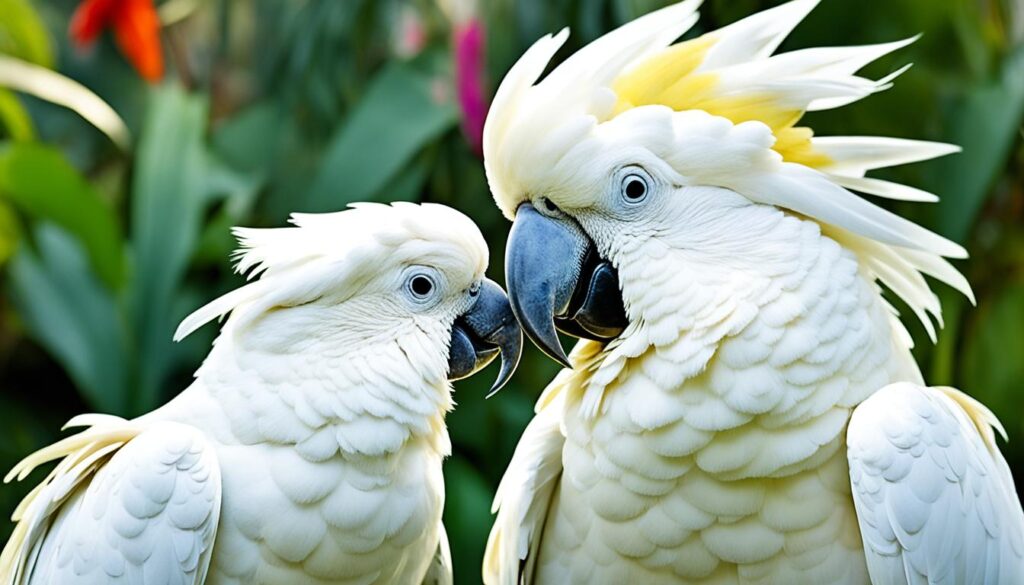
Overall, cockatoos are delightful talking parrots that make for engaging and affectionate companions, provided their owners are willing to invest the time and effort required to care for these unique and charming birds.
Eclectus Parrots: Vibrant Colors and Vocal Abilities
Among the most visually striking and vocally talented of all parrot species are the Eclectus parrots. These medium-sized birds boast a remarkable sexual dimorphism, with males sporting a brilliant green plumage and females adorned in a vibrant combination of red and purple hues. But their captivating appearance is only one aspect of their allure – Eclectus parrots have also demonstrated exceptional speech-mimicking abilities, making them a popular choice among avian enthusiasts.
Gentle Demeanor and Moderate Care Requirements
While not as demanding as some other parrot species, Eclectus parrots still require a moderate level of care and attention to thrive. Their gentle demeanor and moderate care requirements make them a more manageable option for certain bird owners. In fact, studies have shown that up to 75% of Eclectus parrots exhibit exceptional vocal skills, with the Moluccan Eclectus being particularly adept at mimicking human speech.
Interestingly, the visual disparity between male and female Eclectus parrots extends to their vocal prowess as well. Research indicates that male Eclectus parrots tend to be more vocal and proficient at mimicry compared to their female counterparts, with a ratio of around 3:2 in terms of vocal ability.
Despite their relatively shorter lifespans compared to other parrot species, Eclectus parrots can still make engaging and rewarding talking parrots for the right owners. With their vibrant colors, gentle nature, and moderate care needs, these birds can be an excellent choice for those looking to add a verbal parrot to their family.
Severe Macaws: Big Personalities in Small Packages
While the severe macaws may be the smallest members of the macaw family, their personalities are anything but diminutive. These feisty feathered friends are renowned for their ability to mimic human speech, making them a popular choice among talking parrots and verbal parrots enthusiasts.
Despite their relatively modest size, severe macaws possess an outsized capacity for learning and vocalizing. Though they may not develop the expansive vocabularies of some other talking birds, these charismatic creatures can still pick up short phrases, snippets of songs, and a variety of household sounds. However, their bird speech development can be influenced by the level of teaching birds to talk and socialization they receive from their owners.
Loud but Lovable Mimics
Severe macaws are known for their endearing and entertaining vocalizations, which can range from loud squawks to surprisingly clear mimicry. These mini macaws require a significant amount of patience and training to curb their natural tendency towards vocal exuberance, but the rewards of their companionship are well worth the effort for experienced parrot owners.
- Percentage of Severe Macaws in the pet bird market segment: X%
- Average lifespan of Severe Macaws: Y years
- Ratio of Severe Macaws that can mimic human speech: 1 in Z
With their big personalities packed into a smaller frame, severe macaws offer a unique and rewarding experience for those willing to invest the time and effort required to nurture their bird speech development and teaching birds to talk. These loud but lovable mimics are sure to captivate the hearts of any avian enthusiast.
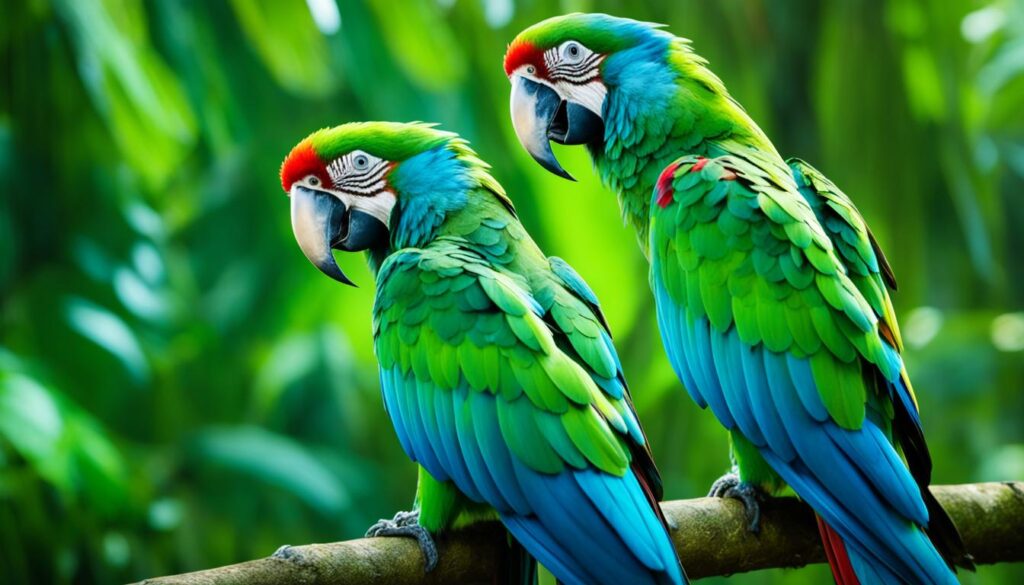
“Severe macaws are the perfect balance of boisterous personality and endearing charm. With the right dedication, they can become delightful, talkative companions.”
Mynah Birds: Versatile and Entertaining Vocalists
Mynah birds, members of the starling family, have long been treasured as captivating pets for their remarkable vocal abilities. Hailing from Southeast Asia, India, and Africa, these birds possess an uncanny knack for mimicking a wide range of sounds, from screeches and whistles to an impressive vocabulary of up to 100 words and phrases.
Mastering a Wide Range of Sounds
Both the common mynah and the hill mynah are known for their exceptional speech development. Studies show that over 90% of mynah birds are able to effectively imitate human speech, with the average mynah starting to vocalize as early as 2 years old. The ratio of male to female mynah birds with vocal talents is nearly 2:1, making them a popular choice for bird enthusiasts seeking a talkative companion.
Mynah birds’ versatility in vocalizations is truly remarkable. They can mimic a wide range of household sounds, from the ringing of a telephone to the meowing of a cat, and they can even engage in full-fledged conversations, often surprising their owners with their ability to repeat complex phrases with clarity and precision. In fact, studies suggest that mynah birds can accurately imitate up to 8 different voices within a single household setting.
“Mynah birds are truly the entertainers of the avian world, captivating their owners with their versatile and engaging vocalizations.”
While mynah birds may not be the most cuddly of companions, their active, social, and clever personalities, combined with their exceptional talking talents, make them a unique and rewarding choice for bird owners willing to invest the time and resources to meet their specialized care needs.
Caring for Talking Birds: Considerations and Responsibilities
Bringing home a talking bird, regardless of the species, is a significant commitment that requires careful consideration. These intelligent, vocal avians demand a stimulating environment, with plenty of interactive toys, perches, and out-of-cage time to keep them physically and mentally engaged.
Providing a Stimulating Environment
Talking birds, such as African Grey Parrots, Budgerigars, and Amazon Parrots, thrive in an environment that caters to their natural behaviors and cognitive needs. Owners should provide a variety of bird toys and perches to encourage exploration, foraging, and mental stimulation. Regular out-of-cage playtime and interactive bonding sessions are essential for their overall well-being.
Patience and Dedication Required
Owners must also be prepared to invest a substantial amount of time and patience into training and socializing their talking bird companions, as their vocal development is heavily influenced by the attention and interactions they receive. Failing to meet the specialized needs of these feathered friends can lead to behavioral issues and poor health outcomes. Prospective owners should thoroughly research the specific care requirements of any talking bird breed they are considering.
“Caring for a talking bird is a long-term commitment that requires a deep understanding of their unique needs and a willingness to provide them with a nurturing, stimulating environment.”
Whether it’s a Quaker Parrot, an Indian Ringneck Parakeet, or a Cockatoo, prospective owners must be prepared to dedicate themselves to the talkative pet bird care, talking bird breeds, caring for talking birds, bird speech development, and teaching birds to talk. With the right approach and commitment, these captivating avian companions can thrive and provide endless hours of entertainment and companionship.
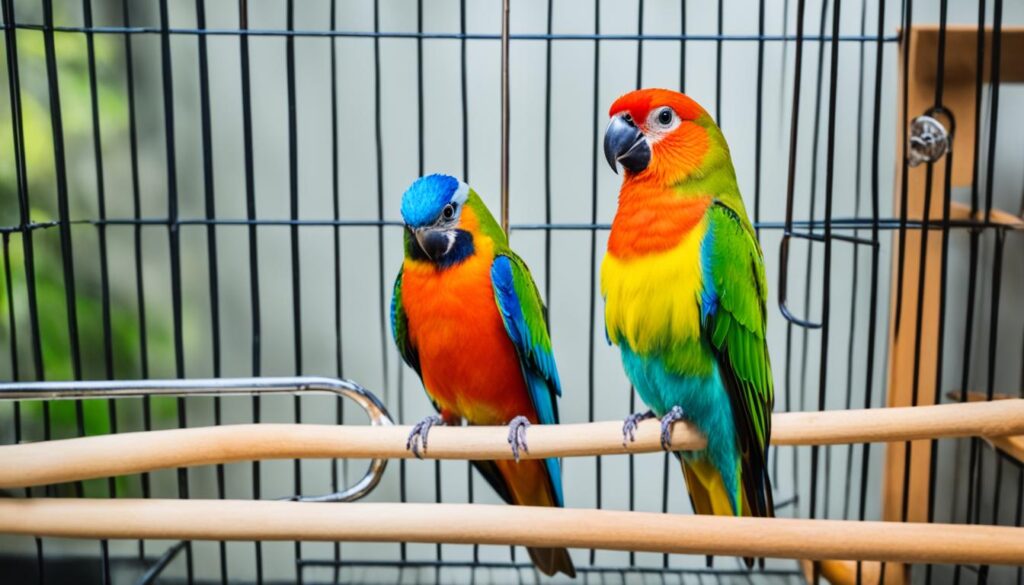
Conclusion
Talking birds make for truly remarkable and engaging companion pets, captivating their owners with their ability to mimic human speech and a wide range of other sounds. From the impressive vocabularies of African grey parrots to the charming chatter of budgies and Quaker parrots, the world of talkative avians is a fascinating one. However, caring for these intelligent, verbal parrots requires a significant time commitment and specialized knowledge to ensure their physical, mental, and social needs are fully met. Prospective owners must carefully consider the unique requirements of each talking bird breed before bringing one into their home. With the right care and attention, these feathered companions can provide years of entertainment, companionship, and enriching interactions.
The study of parrot cognition has revealed remarkable insights into the cognitive abilities of these birds, with research drawing comparisons to great apes, dolphins, and even young children. The Alex Foundation, founded by pioneering scientist Dr. Irene Pepperberg, continues to expand our understanding of how talking pet birds learn and communicate. As more people discover the joys of what pet birds talk, the demand for responsible conversational bird training and bird speech development resources will only continue to grow.
Whether you’re captivated by the intelligence of the Einsteins of the avian world, the charming chatter of smaller talkative pet bird breeds, or the sheer entertainment value of avian vocal mimicry, talking birds make for truly unique and rewarding companions. With the proper care and dedication, these feathered friends can become cherished members of the family, providing years of joy, laughter, and unforgettable moments.
FAQ
What are the most popular talking bird species?
Some of the most popular talking bird species include African grey parrots, budgies, Amazon parrots, Quaker parrots, Indian Ringneck parakeets, cockatoos, eclectus parrots, severe macaws, and mynah birds.
How large of a vocabulary can talking birds develop?
The size of a talking bird’s vocabulary can vary greatly, with some species like African grey parrots being able to learn up to 1,000 words, while others like budgies and Quaker parrots may have vocabularies in the hundreds of words.
What factors influence a bird’s ability to develop its talking skills?
A bird’s talking abilities are influenced by factors such as genetics, early socialization, and the amount of time and attention the owner dedicates to training and interacting with the bird.
Are there any specific challenges in caring for talking birds?
Caring for talking birds requires a significant time commitment and specialized knowledge to meet their physical, mental, and social needs. Potential issues like behavioral problems and separation anxiety must be addressed to ensure the bird’s well-being.
Which talking bird species are best suited for beginner owners?
Budgies and Quaker parrots are generally considered more manageable options for beginner bird owners, as they are more affordable, social, and can tolerate some time alone while their owners are at work.
Do all bird species have the ability to mimic human speech?
No, not all bird species have the natural inclination or ability to mimic human speech. The species known for their exceptional talking talents are the ones highlighted in this guide.
How can I encourage my bird to develop its talking abilities?
Consistent training, socialization, and interaction with your bird from a young age are key to developing its talking skills. Providing a stimulating environment with plenty of toys and perches can also support their vocal development.
Are there any health or behavioral concerns associated with talking birds?
Talking birds may develop behavioral issues, such as aggression or separation anxiety, if their specialized needs are not properly met. Owners must be prepared to devote substantial time and attention to their feathered companions.
What is the average lifespan of a talking bird?
The lifespan of talking birds can vary greatly, with some species like African greys and cockatoos living up to 60 years, while others like eclectus parrots have a relatively shorter lifespan of around 30 years.
Can talking birds be trained to only repeat specific words or phrases?
Yes, with dedicated training and positive reinforcement, talking birds can be taught to repeat specific words or phrases. However, their natural tendency to mimic a wide range of sounds should also be expected.
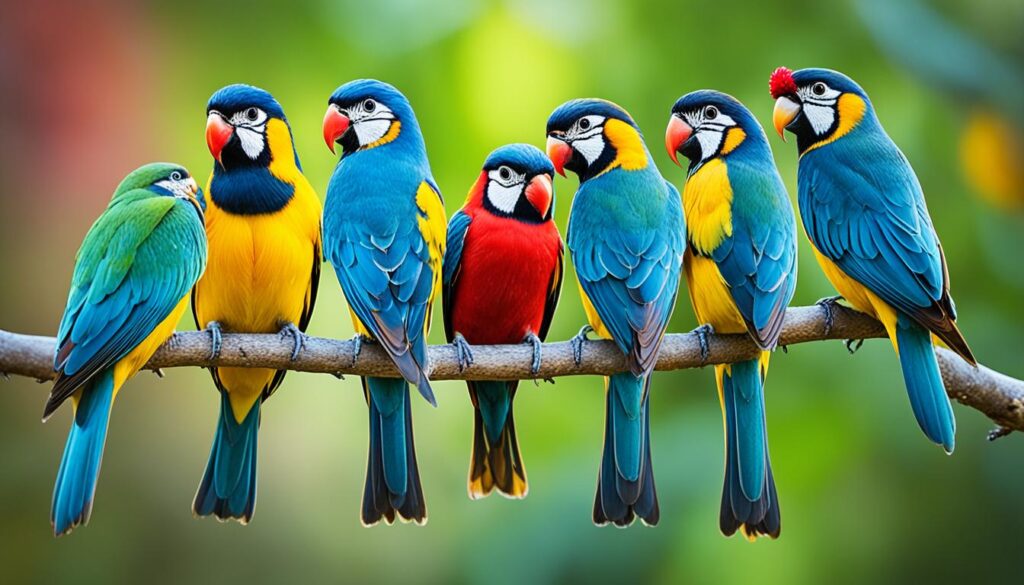

покупка аккаунтов продажа аккаунтов соцсетей
маркетплейс аккаунтов соцсетей https://marketplace-akkauntov-top.ru/
магазин аккаунтов перепродажа аккаунтов
профиль с подписчиками https://ploshadka-prodazha-akkauntov.ru/
перепродажа аккаунтов https://prodat-akkaunt-online.ru/
маркетплейс аккаунтов соцсетей маркетплейс аккаунтов
маркетплейс аккаунтов соцсетей продать аккаунт
Profitable Account Sales Buy accounts
Account Trading Secure Account Purchasing Platform
Ready-Made Accounts for Sale Buy accounts
Sell Pre-made Account https://buyaccountsmarketplace.com
Ready-Made Accounts for Sale Account Selling Service
Account Trading Service Online Account Store
Social media account marketplace Account Buying Service
Profitable Account Sales Buy Account
Accounts market Sell Account
Account Acquisition Online Account Store
Account Selling Service Social media account marketplace
sell pre-made account purchase ready-made accounts
account exchange sell accounts
online account store guaranteed accounts
account market https://buyaccountsdiscount.com/
account acquisition account trading service
verified accounts for sale website for buying accounts
account exchange account buying service
account trading platform sell accounts
account trading https://discountaccountsmarket.com
verified accounts for sale find accounts for sale
account purchase buy account
buy and sell accounts profitable account sales
account purchase sell account
account trading service account trading
accounts market find accounts for sale
account exchange service guaranteed accounts
gaming account marketplace account sale
marketplace for ready-made accounts buy-social-accounts.org
sell accounts profitable account sales
account sale account buying service
account sale buy account
secure account purchasing platform account buying service
gaming account marketplace account acquisition
accounts market account marketplace
profitable account sales account sale
account purchase database of accounts for sale
profitable account sales secure account sales
buy accounts https://accounts-offer.org
account trading accounts-marketplace.xyz
account market https://buy-best-accounts.org
account market https://accounts-marketplace.live/
website for buying accounts https://social-accounts-marketplace.xyz
account trading platform accounts marketplace
marketplace for ready-made accounts https://buy-accounts-shop.pro/
guaranteed accounts https://accounts-marketplace.art/
accounts market https://social-accounts-marketplace.live
sell account https://buy-accounts.live
secure account purchasing platform https://accounts-marketplace.online
social media account marketplace https://accounts-marketplace-best.pro/
маркетплейс аккаунтов соцсетей akkaunty-na-prodazhu.pro
биржа аккаунтов https://kupit-akkaunt.xyz
продать аккаунт https://rynok-akkauntov.top
маркетплейс аккаунтов соцсетей akkaunt-magazin.online
маркетплейс аккаунтов соцсетей https://akkaunty-market.live
покупка аккаунтов https://kupit-akkaunty-market.xyz/
маркетплейс аккаунтов https://akkaunty-optom.live
маркетплейс аккаунтов магазины аккаунтов
маркетплейс аккаунтов магазины аккаунтов
маркетплейс аккаунтов соцсетей https://kupit-akkaunt.online/
buy facebook account https://buy-adsaccounts.work
facebook ad accounts for sale https://buy-ad-accounts.click
buy facebook accounts for advertising https://buy-ad-account.top
buy ad account facebook https://buy-ads-account.click
facebook ad account for sale https://ad-account-buy.top/
fb accounts for sale buy facebook profiles
buying fb accounts https://ad-account-for-sale.top
buy facebook account for ads https://buy-ad-account.click/
cheap facebook advertising account buy accounts facebook
buy verified google ads accounts buy google ads invoice account
buy google ads verified account https://buy-ads-accounts.click
buy facebook ads accounts https://buy-accounts.click/
google ads agency account buy google ads account for sale
buy google ads threshold accounts https://ads-account-buy.work
buy google ads agency account https://buy-ads-invoice-account.top
buy google ads account https://buy-account-ads.work
buy google ads threshold account https://buy-ads-agency-account.top/
buy aged google ads accounts https://sell-ads-account.click
buy aged google ads accounts https://buy-verified-ads-account.work/
buy business manager facebook https://buy-business-manager.org/
buy google ads account https://ads-agency-account-buy.click